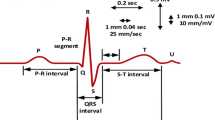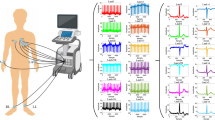Abstract
Wavelet packet transform (WPT) is a powerful mathematical tool for analyzing nonlinear biomedical signals, such as phonocardiogram (PCG). WPT decomposes a PCG signal into a full binary tree of details and approximation coefficients. Appropriate nodes of the tree could be selected as a basis for generating features. Motivated by this, we propose the Renyi entropy basis selection (RenyiBS) method. In RenyiBS method, we use the Renyi entropy as an information measure to choose the best basis of the wavelet packet tree of PCG signals for feature selection and classification. The Renyi entropy estimates the spectral complexity of a signal, which is vital for characterizing nonlinear signals such as PCGs. After selecting the best basis, we define features on the coefficients of the selected nodes. Then, we classify PCGs using the support vector machine (SVM) classifier. In the simulation, we examine a set of 820 heart sound cycles, including normal heart sounds and three types of heart murmurs. The three murmurs examined include aortic regurgitation, mitral regurgitation, and aortic stenosis. We achieved the promising result of 99.74% accuracy, confirming the ability of Renyi entropy to select an appropriate basis of the wavelet packet tree and extracting the nonlinear behavior of particular heart sounds. Besides, the superiority of our proposed information measure in comparison with other information measures reported before is shown.
Similar content being viewed by others
References
Dwivedi AK, Imtiaz SA, Rodriguez-Villegas E (2018) Algorithms for automatic analysis and classification of heart sounds-a systematic review. IEEE Access 7:8316–8345
Coifman RR, Wickerhauser MV (1992) Entropy-based algorithms for best basis selection. IEEE Trans Inf Theory 38(2):713–718
Gradolewski D, Magenes G, Johansson S, Kulesza WJ (2019) A wavelet transform-based neural network denoising algorithm for mobile phonocardiography. Sensors 19(4):957
Boutana D et al (2017) Heart murmurs detection and characterization using wavelet analysis with Renyi entropy. J Mech Med Biol 17(06):1750093
Shi M, Zhan C, He H, Jin Y, Wu R, Sun Y (2019) Renyi distribution entropy analysis of short-term heart rate variability signals and its application in coronary artery disease detection. Front Physiol 10(June):1–14
Rizal A, Hidayat R, Nugroho HA (2019) Comparison of multilevel wavelet packet entropy using various entropy measurement for lung sound classification. Int J Adv Comput Sci Appl 10(2):77–82
Kristomo D, Hidayat R, Soesanti I (2017) Classification of the syllables sound using wavelet, Renyi entropy and AR-PSD features. In: Proceedings of the 2017 IEEE 13th International Colloquium on Signal Processing & its Applications (CSPA) 2017, vol 2, No. March, pp 94–99
Acharya UR et al (2017) Biomedical signal processing and control application of higher-order spectra for the characterization of coronary artery disease using electrocardiogram signals. Biomed Signal Process Control 31:31–43
Acharya UR et al (2017) Application of higher-order spectra for the characterization of coronary artery disease using electrocardiogram signals. Biomed Signal Process Control 31:31–43
Gupta V, Priya T, Yadav AK, Pachori RB, Rajendra Acharya U (2017) Automated detection of focal EEG signals using features extracted from flexible analytic wavelet transform. Pattern Recognit Lett 94:180–188
Xiao B, Xu Y, Bi X, Zhang J, Ma X (2019) Heart sounds classification using a novel 1-D convolutional neural network with extremely low parameter consumption. Neurocomputing, vol in press, No. xxxx, pp 1–7
Bozkurt B, Germanakis I, Stylianou Y (2018) A study of time-frequency features for CNN-based automatic heart sound classification for pathology detection. Comput Biol Med 100:132–143
Hamidi M, Ghassemian H, Imani M (2018) Classification of heart sound signal using curve fitting and fractal dimension. Biomed Signal Process Control 39:351–359
Xu L, Wang Y, Yao Y, Feng C, Zhao YM, Meng Q-H (2010) Comparison of six envelope extraction methods based on abnormal heart sounds. In: 2010 3rd International Conference on Biomedical Engineering and Informatics, No. Bmei, pp 813–817
Saeidi A, Almasganj F, Shojaeifard M (2017) Automatic cardiac phase detection of mitral and aortic valves stenosis and regurgitation via localization of active valves. Biomed Signal Process Control 36:11–19
Choi S, Jiang Z (2008) Comparison of envelope extraction algorithms for cardiac sound signal segmentation. Expert Syst Appl 34(2):1056–1069
Abo-Zahhad M, Ahmed SM, Abbas SN (2016) Biometrics from heart sounds: evaluation of a new approach based on wavelet packet cepstral features using HSCT-11 database. Comput Electr Eng 53:1–13
Li J, Ke LI, Du Q, Ding X, Chen X, Wang D (2019) Heart sound signal classification algorithm: a combination of wavelet scattering transform and twin support vector machine. IEEE Access 7:179339–179348
Li J, Ke L, Du Q (2019) Classification of heart sounds based on the wavelet fractal and twin support vector machine. Entropy 21(5):472
Fern R, Montalvo A, Calvo R, Hern G (2008) Selection of the best wavelet packet nodes based on mutual information for speaker identification. In: Iberoamerican Congress on Pattern Recognition (CIARP) 2008, LNCS 5197, pp 78–85
She B, Tian F, Liang W, Zhang G (2018) De-noising method based on dual-tree complex wavelet packet transform and principal manifold and its application for fault diagnosis. In: 2018 2nd IEEE Advanced Information Management, Communicates, Electronic and Automation Control Conference (IMCEC), No. Imcec, pp 486–491
Cardinali A, Nason GP, Issue S (2017) Locally stationary wavelet packet processes: basis selection and model fitting. J Time Ser Anal 38(2):151–174
Zhang D, He J, Yao J, Wu Y, Du M (2012) Noninvasive detection of mechanical prosthetic heart valve disorder. Comput Biol Med 42(8):785–792
Safara F (2015) Cumulant-based trapezoidal basis selection for heart sound classification. Med Biol Eng Comput 53(11):1153–1164
Safara F, Doraisamy S, Azman A, Jantan A, Abdullah Ramaiah AR (2013) Multi-level basis selection of wavelet packet decomposition tree for heart sound classification. Comput Biol Med 43(10):1407–1414
Wang D, Miao D, Xie C (2011) Best basis-based wavelet packet entropy feature extraction and hierarchical EEG classification for epileptic detection. Expert Syst Appl 38(11):14314–14320
Li L, Han Y, Chen W, Lv C, Sun D (2016) An improved wavelet packet-chaos model for life prediction of space relays based on volterra series. PLoS ONE 11(6):1–13
Choi S, Shin Y, Cheong Y, Lee G-J, Park H-K (2010) Wavelet packet based features for insufficient murmur identification. In: International Conference on Control, Automation and Systems 2010, vol 2, pp 1184–1187
Sugondo H, Suci A, Achmad R (2019) Quantitative EEG based on Renyi entropy for epileptic classification. J Electr Electron Eng 12(1):15–20
Venkataraman V, Arunkumar N, Kumar KR (2018) Entropy features for focal EEG and non focal EEG. J Comput Sci 27:440–444
Zhang T, Chen W, Li M (2018) Fuzzy distribution entropy and its application in automated seizure detection technique. Biomed Signal Process Control 39:360–377
Göbl C, Tjandra N (2012) Application of solution NMR spectroscopy to study protein dynamics. Entropy 14(12):581–598
Renyi A (1961) On measures of entropy and information. In: Fourth Berkeley Symposium on Mathematical Statistics and Probability, vol 1, pp 547–561
Mirjalili S, Faris H, Aljarah I (2020) Evolutionary machine learning techniques. Springer, Singapore
Acknowledgements
The authors gratefully acknowledge the financial and other supports of this research, provided by the Islamic Azad University, Islamshahr Branch, Tehran, Iran.
Author information
Authors and Affiliations
Corresponding author
Additional information
Publisher's Note
Springer Nature remains neutral with regard to jurisdictional claims in published maps and institutional affiliations.
Rights and permissions
About this article
Cite this article
Safara, F., Ramaiah, A.R.A. RenyiBS: Renyi entropy basis selection from wavelet packet decomposition tree for phonocardiogram classification. J Supercomput 77, 3710–3726 (2021). https://doi.org/10.1007/s11227-020-03413-9
Published:
Issue Date:
DOI: https://doi.org/10.1007/s11227-020-03413-9









